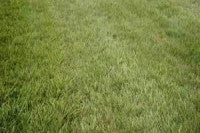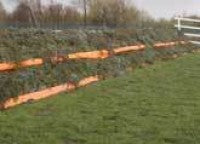Aftermath at Aintree
Aftermath at Aintree
By Laurence Gale

I have always enjoyed the excitement and spectacle of the Aintree Grand National. With a UK TV audience of well over 10.5 million people and a record attendance of over 147,000, the three day event always lives up to its reputation of being one the biggest sporting events in the world. This year was no exception with three glorious days of racing, culminating in Ginger McCain, the famous Red Rum's trainer, securing his 4th Grand National win with Amberleigh House, romping home a 16-1 winner.


The first impression I got when I was driven around the course was its sheer scale and size and the magnitude of work involved in managing such a facility. Aintree actually comprises three race courses; (The Hurdle, The Mildmay and the Grand National) with well over 250 acres of grass to maintain. Within the complex is also a nine-hole golf course.

Adrian has eight full time staff responsible for managing and maintaining all three courses, with two additional staff who manage the golf course. During race meetings, he is able to secure the services of additional staff for divoting and fence repairs. The grass is mowed and maintained at various heights during the growing season using a range of mowers, mainly Turfmech and John Deere Rotaries. It is cut to 100mm (4") during race meetings, 50mm (2") during the summer months and 80mm (3") during the winter months. Adrian needs to ensure there is plenty of grass cover and a strong sward density going into the back end of the growing season, particularly when he has to prepare for a race meeting in November. This helps to reduce turf damage and provide a cushion for the horses.
It was pointed out to me that even though Aintree only has seven race-days a year, the priority is preparing the course for the Grand National. This preparation starts in earnest straight after the last race meeting in November when the repairs to the turf are carried out. His main aim is to complete all the works quickly before the weather declines and temperatures drop. This usually involves a number of tasks:
- Divot repairs
- Restoring levels
- Overseeding
- Fertilising
- Mowing
Divoting:
Divot repairs are a priority and need to be completed quickly. Horses, when they land, cause physical damage to the turf. Depending on the going conditions of the course, a hoof print will leave a 100-200mm (4-8") deep punch hole. Multiply that by four hooves and 100 plus horses and the scale of damage that occurs after a race meeting can be imagined. Top dressing the divots is the most efficient and safe method of repair. Usually groundsmen use a fork to lift the divot however at Aintree, this method would leave an unstable repair, which would then cause inconsistent levels or false ground. After last November's meeting, Adrian and his staff applied well over 300 tonnes of dressing to infill all the divot damage.
Restoring Levels:
A Cambridge roller is used to restore levels after the racing.
Overseeding:
A Gannon seeder is utilised, applying well over 1600kg (80 bags) of rye grass seed @ 35 grams per square metre to overseed the course.
Fertilising:
Weather permitting, staff will apply some bio stimulants to the repaired areas to assist any new seed growth. When weather conditions allow, a winter fertiliser 4/12/12 is applied to assist recovery and keep a good winter colour. The priority throughout the winter months is to keep the sward healthy and free from disease. Trying to promote as much growth as possible enables a good start for the preparations for the Grand National in April.
Mowing:
During the winter period the grass will be maintained at 80mm (3") to keep the sward tidy and even.
The weather during the winter period was a key factor to how well the grass recovered, giving the chance to prepare and aspire to the standards of preparation expected for this year's Grand National, especially as it was Martell's last sponsorship of this great race meeting. During March, another 600kg (30 bags of seed) was applied. It was mixed with pen-mulch, a product that when applied to any worn and bare areas, initiates rapid seed germination. This provides another opportunity to obtain more grass growth on the course prior to the Grand National. Fortunately, the sandy loam soil at the course has the advantage that it warms up quickly in the spring, enabling a quick response to any fertiliser applications. Three weeks before the Grand National Adrian applied a 9/7/7 spring fertiliser to get the grass moving.

The weather during this year's preparation fluctuated, with periods of warm and cold spells interspersed with rain and wind, which actually began to dry out the course. Adrian likes to keep the course maintained the "softer side of good" going all year round, enabling a safe and manageable surface for the horses and turf growth. A careful eye is kept on the weather to prevent the course drying out and becoming hard. One 50 and a 30-metre wide boom irrigator, and some rain guns are used to irrigate courses. This enables the staff to put on water to a depth of 12 mm across the course per day if required.

With 16 fences to repair and prepare for the National, it usually takes two men two days to strip and re-lay a single fence with spruce materials The fence-building programme at Aintree starts approximately one month before the Martell Cognac Grand National is run, with spruce sourced and transported from the Lake District. Final preparation, which takes two man days, involves cutting the grass at 100mm to produce the familiar stripes which results in the course looking its best for the National. Other jobs include preparing and maintaining all shrub and lawn areas around the site, ensuring they are looking their best for the three-day event.
The Grand National event is a busy time for Adrian and his staff. They are required to work long hours during the build up and duration of the 3 day meeting, starting at six in the morning and not finishing until all the jobs are completed. During the event, well over 150 staff are employed to help keep the course up to the expected standards. This includes over 60 staff to put the divots back, working in two teams of thirty starting at each end of the course. With over 2.5 miles of turf to divot it is a mammoth job. This operation is carried out after each day's racing. It is the equivalent of divoting 22 football pitches each day!


After the National, Adrian and his staff have about six weeks to prepare and tidy up the course for the next meeting in May. The cycle is repeated, divot repairs are carried out to restore levels and the turf is overseeded and fed. However, a different seed mixture (MM25) will be sown at a rate of over 2000kg (100 bags) of seed at 35grams per metre. A Monsoon wetting agent is applied on some of the dry areas of the course to help water infiltration into the soil profile. This is reported to be working very well, maximising the efficiency of irrigation on the course. Irrigation is a main concern, as the ground needs to be maintained at softer side of good going. Last year about 16,000 cubic metre of water was used to keep the course in good condition. Two Verti drain machines are used in June and July to decompact the courses.

This was Adrian's fourth Grand National. Each time the preparation has been different and required different inputs and strategies to achieve the level of preparation expected for the Aintree Course. However, each year Adrian has seen a reduction in the damage, he puts this down to all the preventative and repair work carried out by his team and to the fact that he is able to utilise new technologies and better materials. He feels that this has resulted in a course with an improved appearance and a greater resistance to damage.
Adrian and his staff are rewarded by knowing that everybody who attends or sees the race on TV are able to see the results of his hard work. The Grand National continues to be considered by many to be the greatest horse steeplechase race meeting of the year.
